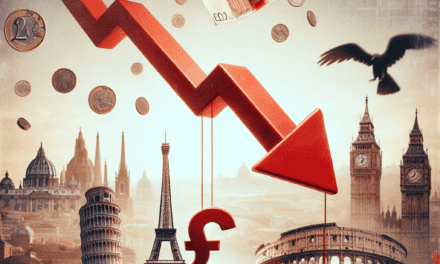“Maximize Gains: Smart Strategies for Investors as Gold Nears New Heights”
Introduction
As gold prices approach record highs, investors are faced with both opportunities and challenges in navigating this dynamic market. The allure of gold as a safe-haven asset becomes particularly pronounced during periods of economic uncertainty, inflationary pressures, and geopolitical tensions. For investors, developing effective strategies is crucial to capitalize on potential gains while mitigating risks. This involves a comprehensive understanding of market trends, diversification techniques, and timing considerations. By exploring various investment vehicles such as physical gold, exchange-traded funds (ETFs), and mining stocks, investors can tailor their approaches to align with their financial goals and risk tolerance. Additionally, staying informed about macroeconomic indicators and global events can provide valuable insights into gold’s price movements, enabling investors to make informed decisions in this ever-evolving landscape.
Understanding Market Trends: Analyzing Gold’s Historical Performance
As gold approaches record highs, investors are increasingly focused on understanding market trends and analyzing the historical performance of this precious metal. Gold has long been considered a safe haven asset, particularly during times of economic uncertainty. Its value is often driven by a combination of factors, including inflation rates, currency fluctuations, and geopolitical tensions. To develop effective investment strategies, it is crucial to examine how these elements have historically influenced gold prices and to consider how they might continue to do so in the future.
Historically, gold has demonstrated a strong inverse relationship with the U.S. dollar. When the dollar weakens, gold prices tend to rise, as investors seek to protect their wealth from currency depreciation. This relationship can be traced back to the abandonment of the gold standard in the early 1970s, which allowed gold prices to fluctuate freely in response to market forces. Since then, periods of dollar weakness have often coincided with significant increases in gold prices. For instance, during the financial crisis of 2008, the dollar’s decline was accompanied by a surge in gold prices, as investors flocked to the metal as a store of value.
In addition to currency dynamics, inflation is another critical factor influencing gold’s historical performance. Gold is often viewed as a hedge against inflation, as its value tends to rise when the purchasing power of fiat currencies erodes. This characteristic was particularly evident during the 1970s, a decade marked by high inflation rates and substantial increases in gold prices. More recently, concerns about inflation have resurfaced, driven by expansive monetary policies and supply chain disruptions. As a result, investors are once again turning to gold as a means of preserving their wealth in an inflationary environment.
Geopolitical tensions also play a significant role in shaping gold’s market trends. During times of political instability or conflict, gold is often perceived as a safe investment, leading to increased demand and higher prices. Historical events such as the Gulf War, the 9/11 attacks, and the ongoing tensions in the Middle East have all contributed to spikes in gold prices. As global uncertainties persist, investors continue to monitor geopolitical developments closely, recognizing their potential impact on gold’s performance.
While understanding these historical trends is essential, investors must also consider current market conditions and future projections. As gold approaches record highs, it is important to assess whether these levels are sustainable or if a correction is likely. Factors such as central bank policies, interest rates, and global economic growth will play a crucial role in determining gold’s trajectory. For instance, if central banks decide to tighten monetary policy to combat inflation, this could lead to higher interest rates, which might dampen gold’s appeal as an investment.
In conclusion, analyzing gold’s historical performance provides valuable insights into the factors that drive its market trends. By understanding the interplay between currency dynamics, inflation, and geopolitical tensions, investors can develop informed strategies as gold approaches record highs. However, it is equally important to remain vigilant and adaptable, considering both historical patterns and current market conditions. By doing so, investors can better navigate the complexities of the gold market and make informed decisions that align with their financial goals.
Diversification Tactics: Balancing Gold with Other Asset Classes
As gold prices approach record highs, investors are increasingly considering how to effectively incorporate this precious metal into their portfolios. While gold has long been regarded as a safe haven during times of economic uncertainty, its rising value prompts a reevaluation of diversification strategies. Balancing gold with other asset classes is crucial to achieving a well-rounded investment portfolio that can withstand market volatility and capitalize on growth opportunities.
To begin with, understanding the role of gold in a diversified portfolio is essential. Gold is often seen as a hedge against inflation and currency devaluation, providing stability when traditional markets experience turbulence. However, relying solely on gold can expose investors to risks associated with price fluctuations driven by geopolitical events or changes in monetary policy. Therefore, integrating gold with a mix of other asset classes can mitigate these risks while enhancing potential returns.
One effective strategy is to pair gold with equities. Stocks offer growth potential that gold typically lacks, as they are tied to the performance of individual companies and broader economic trends. By investing in a diverse range of equities, investors can benefit from capital appreciation while using gold to offset potential losses during market downturns. This approach allows for a balanced risk-reward profile, as the stability of gold complements the growth prospects of equities.
In addition to equities, fixed-income securities such as bonds can play a vital role in a diversified portfolio. Bonds provide regular income through interest payments and are generally less volatile than stocks. When combined with gold, bonds can offer a steady income stream while reducing overall portfolio risk. This combination is particularly appealing during periods of low interest rates, as gold’s value may rise in response to inflationary pressures, thereby preserving purchasing power.
Moreover, real estate investments can further enhance diversification efforts. Real estate often exhibits low correlation with both gold and traditional financial markets, making it an attractive addition to a diversified portfolio. By investing in real estate, either directly or through real estate investment trusts (REITs), investors can gain exposure to tangible assets that generate income and appreciate over time. This diversification tactic can provide a buffer against market volatility, as real estate values are influenced by different factors than those affecting gold and other financial assets.
Furthermore, alternative investments such as commodities and cryptocurrencies can also be considered when diversifying alongside gold. Commodities, like oil and agricultural products, offer exposure to different economic sectors and can act as a hedge against inflation. Cryptocurrencies, while more volatile, present opportunities for significant returns and can add a modern twist to traditional diversification strategies. However, it is crucial to approach these alternatives with caution, as they come with their own set of risks and require thorough research and understanding.
In conclusion, as gold approaches record highs, investors must carefully consider how to balance this precious metal with other asset classes to achieve optimal diversification. By integrating equities, fixed-income securities, real estate, and alternative investments, investors can create a robust portfolio that not only capitalizes on gold’s stability but also harnesses the growth potential of other assets. This strategic approach ensures that investors are well-prepared to navigate the complexities of the financial markets, regardless of economic conditions.
Timing the Market: When to Buy and Sell Gold
As gold prices approach record highs, investors are increasingly focused on the timing of their market activities, particularly when it comes to buying and selling this precious metal. Understanding the nuances of market timing can be crucial for maximizing returns and minimizing risks. To begin with, it is essential to recognize that gold, unlike other commodities, often serves as a hedge against economic uncertainty and inflation. This unique characteristic makes it a popular choice during times of financial instability, which can lead to significant price fluctuations.
One of the primary strategies for timing the gold market is to closely monitor economic indicators. For instance, inflation rates, interest rates, and currency fluctuations can all have a profound impact on gold prices. When inflation is on the rise, gold often becomes more attractive as a store of value, leading to increased demand and higher prices. Conversely, when interest rates are high, the opportunity cost of holding non-yielding assets like gold increases, potentially leading to a decrease in demand. Therefore, keeping a keen eye on these economic indicators can provide valuable insights into the optimal times to buy or sell gold.
In addition to economic indicators, geopolitical events can also play a significant role in influencing gold prices. Political instability, conflicts, and trade tensions can create uncertainty in global markets, prompting investors to seek the relative safety of gold. During such times, prices may surge as demand increases. Thus, staying informed about global political developments can help investors make more informed decisions about when to enter or exit the gold market.
Another important consideration is the role of market sentiment. Investor psychology can often drive market trends, sometimes leading to price movements that are not entirely justified by economic fundamentals. For example, during periods of market exuberance, prices may rise rapidly as investors rush to buy, fearing they might miss out on potential gains. Conversely, during times of pessimism, prices may fall as investors sell off their holdings. Understanding these psychological factors and recognizing patterns of investor behavior can be instrumental in timing market activities effectively.
Moreover, technical analysis can be a valuable tool for investors looking to time their gold transactions. By examining historical price charts and identifying patterns or trends, investors can gain insights into potential future price movements. Technical indicators such as moving averages, relative strength index (RSI), and Fibonacci retracements can provide additional guidance on when to buy or sell. However, it is important to note that technical analysis should be used in conjunction with other strategies, as it is not foolproof and can sometimes lead to misleading conclusions.
Finally, diversification remains a key strategy for managing risk in any investment portfolio, including those with significant gold holdings. By spreading investments across different asset classes, investors can mitigate the impact of adverse price movements in any single market. This approach allows for greater flexibility in timing market activities, as investors are not overly reliant on the performance of gold alone.
In conclusion, while timing the gold market can be challenging, a combination of strategies can enhance an investor’s ability to make informed decisions. By closely monitoring economic indicators, staying abreast of geopolitical developments, understanding market sentiment, utilizing technical analysis, and maintaining a diversified portfolio, investors can better navigate the complexities of the gold market as prices approach record highs.
Risk Management: Hedging Against Volatility with Gold

As gold prices approach record highs, investors are increasingly turning their attention to this precious metal as a means of hedging against market volatility. The allure of gold as a safe-haven asset is well-documented, particularly during times of economic uncertainty and geopolitical tension. However, while gold can serve as an effective tool for risk management, it is crucial for investors to employ strategic approaches to maximize its benefits and mitigate potential downsides.
To begin with, understanding the role of gold in a diversified investment portfolio is essential. Gold has historically exhibited a low correlation with other asset classes, such as equities and bonds, making it an attractive option for diversification. By including gold in a portfolio, investors can potentially reduce overall risk and enhance returns, especially during periods of market turbulence. However, it is important to note that gold should not be viewed as a panacea for all investment challenges. Instead, it should be considered as one component of a broader risk management strategy.
In addition to diversification, timing plays a critical role in the effective use of gold as a hedge. Investors should be mindful of the economic indicators and market conditions that typically drive gold prices. For instance, inflationary pressures, currency fluctuations, and interest rate changes can all influence the demand for gold. By staying informed about these factors, investors can make more informed decisions about when to increase or decrease their exposure to gold. Moreover, it is advisable to adopt a long-term perspective when investing in gold, as short-term price fluctuations can be unpredictable and may not accurately reflect the metal’s intrinsic value.
Another strategy for managing risk with gold involves the use of financial instruments such as futures contracts, options, and exchange-traded funds (ETFs). These instruments allow investors to gain exposure to gold without the need to physically own the metal. Futures contracts, for example, enable investors to lock in a specific price for gold at a future date, providing a hedge against price volatility. Similarly, options offer the flexibility to buy or sell gold at predetermined prices, allowing investors to capitalize on market movements while limiting potential losses. ETFs, on the other hand, offer a convenient way to invest in gold by tracking its price and providing liquidity and ease of trading.
Furthermore, it is essential for investors to consider the costs associated with investing in gold. These costs can include storage fees for physical gold, management fees for ETFs, and transaction costs for buying and selling futures or options. By carefully evaluating these expenses, investors can ensure that their gold investments remain cost-effective and aligned with their overall financial goals.
In conclusion, as gold approaches record highs, it presents both opportunities and challenges for investors seeking to hedge against market volatility. By incorporating gold into a diversified portfolio, staying informed about economic indicators, utilizing financial instruments, and managing associated costs, investors can effectively leverage gold as a risk management tool. Ultimately, a well-considered approach to investing in gold can help investors navigate uncertain markets and achieve greater financial stability.
Investment Vehicles: Exploring Gold ETFs, Futures, and Physical Gold
As gold prices approach record highs, investors are increasingly turning their attention to this precious metal as a potential safe haven and a means of diversifying their portfolios. The allure of gold lies in its historical role as a store of value, particularly during times of economic uncertainty and inflationary pressures. However, investing in gold is not a one-size-fits-all endeavor. There are several investment vehicles available, each with its own set of advantages and considerations. Among these, gold exchange-traded funds (ETFs), futures contracts, and physical gold stand out as prominent options.
Gold ETFs have gained popularity due to their convenience and liquidity. These funds are designed to track the price of gold, allowing investors to gain exposure to the metal without the need to physically own it. One of the primary benefits of gold ETFs is their ease of trading on major stock exchanges, similar to individual stocks. This feature provides investors with the flexibility to buy and sell shares throughout the trading day, making it an attractive option for those seeking to capitalize on short-term price movements. Additionally, gold ETFs often have lower transaction costs compared to purchasing physical gold, making them a cost-effective choice for many investors.
On the other hand, gold futures contracts offer a different approach, appealing to those with a more speculative mindset. Futures contracts allow investors to agree on a price for gold to be delivered at a future date, providing an opportunity to profit from anticipated price changes. This leverage can amplify gains, but it also increases the potential for significant losses, making futures a more suitable option for experienced investors with a higher risk tolerance. Moreover, trading in futures requires a thorough understanding of the market and the ability to closely monitor price fluctuations, as the contracts are typically short-term in nature.
For those who prefer a tangible asset, investing in physical gold remains a timeless choice. This can be in the form of gold bars, coins, or jewelry. Physical gold offers the advantage of direct ownership, providing a sense of security that paper assets cannot match. It is also free from counterparty risk, as it does not rely on any financial institution or intermediary. However, owning physical gold comes with its own set of challenges, including storage and insurance costs. Investors must also be cautious of potential premiums over the spot price when purchasing gold from dealers.
In navigating these options, it is crucial for investors to consider their individual financial goals, risk tolerance, and investment horizon. Diversification remains a key strategy, and incorporating a mix of gold investment vehicles can help mitigate risks while maximizing potential returns. For instance, combining the liquidity of gold ETFs with the tangible security of physical gold can provide a balanced approach. Furthermore, staying informed about global economic trends and geopolitical developments can aid in making timely investment decisions.
In conclusion, as gold approaches record highs, investors have a variety of strategies at their disposal. Whether opting for the convenience of ETFs, the speculative nature of futures, or the tangible appeal of physical gold, each vehicle offers unique benefits and challenges. By carefully assessing their investment objectives and market conditions, investors can effectively harness the potential of gold to enhance their portfolios and achieve long-term financial stability.
Economic Indicators: How Global Events Impact Gold Prices
As gold prices approach record highs, investors are keenly observing the economic indicators that influence these fluctuations. Understanding how global events impact gold prices is crucial for making informed investment decisions. Historically, gold has been perceived as a safe-haven asset, offering protection against economic uncertainty and inflation. This perception is largely due to its intrinsic value and limited supply, which contrasts with fiat currencies that can be subject to devaluation. Consequently, when global events create economic instability, investors often flock to gold, driving up its price.
One of the primary economic indicators affecting gold prices is inflation. When inflation rates rise, the purchasing power of currencies diminishes, prompting investors to seek assets that can preserve value. Gold, with its historical reputation as a hedge against inflation, becomes an attractive option. For instance, during periods of high inflation, such as the 1970s, gold prices surged as investors sought refuge from eroding currency values. Therefore, monitoring inflation trends can provide valuable insights into potential movements in gold prices.
In addition to inflation, interest rates play a significant role in determining gold prices. Generally, there is an inverse relationship between interest rates and gold prices. When interest rates are low, the opportunity cost of holding non-yielding assets like gold decreases, making it more appealing to investors. Conversely, when interest rates rise, investors may prefer interest-bearing assets, leading to a decline in gold demand. Central banks’ monetary policies, particularly those of major economies like the United States, are closely watched by investors as they can signal changes in interest rates and, consequently, influence gold prices.
Geopolitical tensions and global crises are also pivotal in shaping gold prices. Events such as wars, political instability, and pandemics can create uncertainty in financial markets, prompting investors to seek the safety of gold. For example, during the COVID-19 pandemic, gold prices reached new heights as the global economy faced unprecedented challenges. Similarly, ongoing geopolitical tensions, such as trade disputes or military conflicts, can lead to increased demand for gold as a protective measure against potential economic fallout.
Currency fluctuations, particularly those involving the US dollar, are another critical factor impacting gold prices. Since gold is primarily traded in US dollars, any significant changes in the dollar’s value can affect gold’s price. A weaker dollar makes gold cheaper for holders of other currencies, potentially boosting demand and driving up prices. Conversely, a stronger dollar can make gold more expensive, reducing demand and exerting downward pressure on prices. Therefore, keeping an eye on currency markets and exchange rate trends is essential for investors looking to navigate the gold market effectively.
In conclusion, as gold approaches record highs, investors must consider a range of economic indicators and global events that influence its price. By understanding the interplay between inflation, interest rates, geopolitical tensions, and currency fluctuations, investors can develop strategies to capitalize on gold’s movements. While gold remains a valuable asset in times of uncertainty, it is essential for investors to stay informed and adapt their strategies to the ever-changing economic landscape. This approach will enable them to make prudent investment decisions and potentially benefit from the opportunities presented by gold’s ascent to record levels.
Long-term vs. Short-term: Strategic Approaches to Gold Investment
As gold prices approach record highs, investors are faced with the critical decision of how best to position themselves in this dynamic market. The allure of gold as a safe-haven asset is well-documented, particularly during times of economic uncertainty and inflationary pressures. However, the strategies for investing in gold can vary significantly depending on whether one adopts a long-term or short-term perspective. Understanding these strategic approaches is essential for investors aiming to maximize their returns while managing risk effectively.
In the realm of long-term investment, gold is often viewed as a hedge against inflation and currency devaluation. Historically, gold has maintained its value over time, making it an attractive option for those looking to preserve wealth. Long-term investors typically focus on the fundamental factors that drive gold prices, such as macroeconomic trends, geopolitical tensions, and central bank policies. By holding gold over an extended period, these investors aim to benefit from its potential appreciation while mitigating the impact of market volatility. Moreover, long-term strategies often involve diversifying one’s portfolio with a mix of gold-related assets, including physical gold, exchange-traded funds (ETFs), and mining stocks, to spread risk and enhance potential returns.
Conversely, short-term investors are more concerned with capitalizing on price fluctuations and market trends. These investors often employ technical analysis to identify entry and exit points, relying on charts and indicators to guide their decisions. The short-term approach requires a keen understanding of market sentiment and the ability to react swiftly to changing conditions. For instance, during periods of heightened market volatility, short-term traders might take advantage of price swings by engaging in speculative trading or using derivatives such as options and futures contracts. This approach, while potentially lucrative, also carries a higher degree of risk, necessitating a disciplined risk management strategy to protect against significant losses.
Transitioning from one strategy to another is not uncommon, as market conditions and individual investment goals evolve. For instance, an investor initially focused on short-term gains might shift to a long-term strategy if they perceive a sustained upward trend in gold prices. Conversely, a long-term investor might decide to capitalize on short-term opportunities during periods of heightened volatility. This flexibility allows investors to adapt to the ever-changing market landscape, ensuring that their investment approach remains aligned with their financial objectives.
Furthermore, the choice between long-term and short-term strategies is often influenced by an investor’s risk tolerance and time horizon. Those with a higher risk appetite and shorter time frames may gravitate towards short-term trading, while more risk-averse individuals with longer investment horizons might prefer the stability of a long-term approach. It is crucial for investors to assess their personal circumstances and financial goals before committing to a particular strategy.
In conclusion, as gold approaches record highs, investors must carefully consider their strategic approach to maximize potential returns while managing risk. Whether adopting a long-term perspective focused on wealth preservation or a short-term approach aimed at capitalizing on market movements, understanding the nuances of each strategy is essential. By remaining informed and adaptable, investors can navigate the complexities of the gold market and make informed decisions that align with their investment objectives.
Q&A
1. **Question:** What is a common strategy for investors when gold prices approach record highs?
**Answer:** Diversification is a common strategy, where investors allocate a portion of their portfolio to gold to hedge against market volatility and inflation.
2. **Question:** How can investors use gold ETFs as a strategy?
**Answer:** Investors can buy gold ETFs to gain exposure to gold prices without the need to physically own the metal, providing liquidity and ease of trading.
3. **Question:** What role does technical analysis play in gold investment strategies?
**Answer:** Technical analysis helps investors identify trends and potential entry and exit points by analyzing price charts and patterns, aiding in timing their investments.
4. **Question:** Why might investors consider gold mining stocks as part of their strategy?
**Answer:** Gold mining stocks can offer leveraged exposure to gold prices, potentially providing higher returns if gold prices rise, but also come with higher risk.
5. **Question:** How does geopolitical uncertainty influence gold investment strategies?
**Answer:** Geopolitical uncertainty often leads investors to increase their gold holdings as a safe-haven asset, anticipating that such events may drive gold prices higher.
6. **Question:** What is a contrarian strategy regarding gold investments?
**Answer:** A contrarian strategy involves selling gold when prices are high and buying when prices are low, going against prevailing market trends to capitalize on price corrections.
7. **Question:** How can options be used in a gold investment strategy?
**Answer:** Investors can use options to hedge their gold investments or speculate on price movements, allowing them to manage risk or leverage their positions with limited capital.
Conclusion
As gold approaches record highs, investors should consider a diversified strategy to manage risk and capitalize on potential gains. Firstly, it’s crucial to assess the broader economic environment, including inflation trends, currency fluctuations, and geopolitical tensions, which often drive gold prices. Investors might consider a mix of physical gold, such as bullion or coins, and financial instruments like gold ETFs or mining stocks to balance liquidity and potential returns. Additionally, maintaining a long-term perspective can help mitigate the volatility associated with gold markets. It’s also wise to regularly review and adjust the investment portfolio in response to market changes and personal financial goals. By employing a well-rounded approach, investors can effectively navigate the complexities of the gold market and enhance their overall investment strategy.





